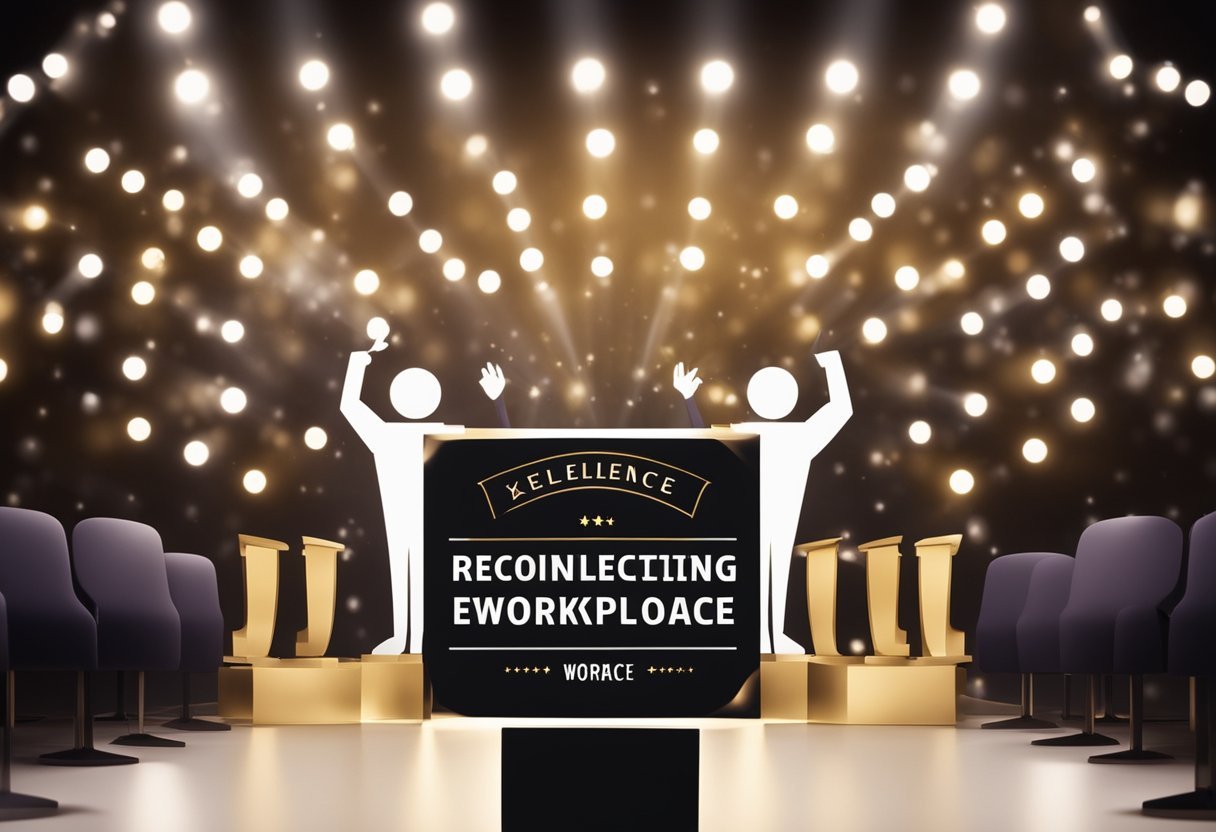Mais propensos a prêmios para funcionários – Reconhecendo contribuições únicas no trabalho
Recognising employees’ contributions through ‘Most Likely To’ awards can be a playful yet powerful way to appreciate the diverse talents and quirks within a workplace.
These awards take a humorous spin on traditional forms of recognition, catering to various personalities and achievements in an organisation. By highlighting unique traits, achievements, and even amusing habits, they serve not only as a catalyst for laughter and bonding but also as a way to celebrate individuality and team spirit.

By implementing a thoughtfully designed awards programme, companies can foster a culture of appreciation that acknowledges the importance of every team member’s role.
These awards create memorable moments and demonstrate an organisation’s commitment to valuing work well beyond the standard metric success metrics rating career milestones, displaying certain valued behaviours, or simply bringing a particular team, ‘Most Likely To’ awards can ingeniously reflect the company’s ethos and enhance employee motivation.
Most Likely to Awards for Employees – Key Takeaways
- ‘Most Likely To’ awards recognise diverse talents and foster workplace camaraderie.
- Thoughtful award programmes contribute to a culture of appreciation.
- Celebrating individuality with such awards boosts motivation and team spirit.
Recognising Excellence in the Workplace

Moder acknowledges achievements through a structured recognition programme, which is crucial. It is a sign of modern organisations’ appreciation and reinforces company values.
Types of Recognition and Awards
Myriad recognition can be linked to a company’s unique culture and values. Common causes:
- Performance-based awards are typically given for achieving specific targets or outstanding contributions to the company’s Contributing Contributions Month” or “Top Salesperson Award.”
- Years of Service Awards: Acknowledging loyalty and commitment, these awards might be given on significant anniversaries, such as 5, 10, or 20 years of service.
- Peer-to-Peer Recognition: Allows employees to nominate their colleagues, fostering a sense of camaraderie and teamwork.
- Retirement Awards: These honour the long-term dedication of a retiring employee.
- Innovation Awards: These are specific to those who have contributed new ideas that have benefited the company.
The items used for awards include plaques, trophies, certificates, or personalised gifts that resonate with the employees.
Critical Elements of a Successful Recognition Program
A successful recognition programme should encapsulate the following features to ensure its effectiveness:
- Alignment with Company Culture: The program must echo the fundamental values and goals of the business.
- Leadership Involvement: Active participation from management is essential to give the programme credibility and weight.
- Consistência: Awards should be given regularly and predictably to maintain fairness and integrity.
- Personalização: Recognising employees in a way that is meaningful to them can increase the award’s impact.
- Visibilidade: Public recognition can enhance the motivational effect for the awardee and the entire organisation.
- Feedback Integration: The programme should incorporate feedback mechanisms for continuous improvement.
By integrating these principles, a company can not only motivate their workforce but also strengthen its internal community, reinforcing a positive and productive company culture.
Designing Your Awards Programme

In constructing a well-rounded awards programme, the focus should lie on meticulous planning and a diverse categorisation of awards that underscore pivotal contributions and milestones within the organisation.
Planning and Implementation
The first stage to ushering in an efficacious awards programme is planning. This encompasses conceptualising a framework that aligns with the company’s ethos and envisions the desired culture of recognition. A creative approach is vital, marrying innovation with your organisation’s unique identity to foster a genuine appreciation system.
A step-by-step list for execution may look like this:
- Determine objectives that the programme aims to achieve.
- Allocate a budget and resources required to sustain the awards.
- Choose a system for nominating and selecting winners.
- Set up a schedule for when awards will be given.
- Communicate the programme details across the organisation.
Award Categories and Criteria
Within the awards programme, ideas should be diverse and reflect different aspects of an employee’s performance and contributions. Here are some award categories and their potential criteria:
Teamwork
- Team Player Award: Granted to individuals who exemplify cooperative spirit and collaborative efficiency.
- Leadership Awards: Recognise those who lead by example, motivating and guiding their peers.
Recognition of Excellence
- Employee of the Month Award: Rewards consistent excellence in performance and attitude.
- Customer Service Award: For individuals who provide exceptional service, going above and beyond for clients.
- Above and Beyond Award: Acknowledges remarkable efforts that surpass standard expectations.
Acknowledgment of Commitment
- Years of Service Award: Celebrates long-term dedication and loyalty to the company.
- Spotlight Award: Shines a light on those who may not be in leadership positions but make considerable impacts behind the scenes.
Spot Recognition
- Consider It Done Award: Honours the can-do attitude of employees who tackle challenges head-on.
Each category should have explicit criteria attached to it, ensuring a fair and transparent selection process. It’s crucial that the programme is accessible and understood by all employees, thus reinforcing its integrity and the value it represents.
Cultivating a Culture of Appreciation
Cultivating a workplace appreciation culture hinges on aligning recognition programmes with company values and the active engagement of both employees and leadership.
Integrating Award Programmes with Company Values
A robust culture of appreciation starts with meaningful recognition that resonates with the company’s core values. It involves tailoring award programmes to reflect what the organisation stands for and ensuring that these values are clearly communicated and consistently expressed through public recognition.
For example, if a company prioritises innovation, awards like ‘Most Innovative Solution’ could be introduced, reinforcing the value through acknowledgement.
Company Values to Award Alignment:
- Innovation: ‘Most Innovative Solution’
- Teamwork: ‘Outstanding Collaborator’
- Customer Focus: ‘Customer Success Champion’
By integrating awards like these with company values, employees experience appreciation for their efforts and are encouraged to embody them in their work.
Engaging Employees and Leadership
Employee engagement in a culture of appreciation is multi-faceted, involving both recognition from leadership and employee participation. Leaders should be trained to provide consistent e public recognition, which can significantly boost employee morale and motivation. They are role models in fostering an environment where recognition is integral to daily interactions.
Furthermore, encouraging employees to acknowledge their peers promotes a sense of community and mutual respect.
Critical Practices for Engagement:
- Leadership involvement: Regular shout-outs and personal commendations from senior team members.
- Employee-led recognition: Nomination systems for peers to celebrate each other’s contributions.
By encouraging this two-way appreciation stream, companies can bolster workplace culture and engagement, creating an environment where every employee feels valued and motivated.
Impact of Employee Recognition
Employee recognition significantly influences workplace dynamics and individual attitudes. It is a powerful tool for reinforcing company values and enhancing overall job satisfaction.
Effects on Team Dynamics and Productivity
Employee recognition can have profound effects on team dynamics. It fosters a culture of appreciation that can lead to increased produtividade and collaboration. Teams that regularly recognise the efforts of their members often report:
- Improved Cooperation: Individuals tend to be more willing to work together and support one another.
- Produtividade aprimorada: Acknowledgement can boost individual performance, cumulatively improving team output.
Benefits for Retention and Morale
The benefits of employee recognition extend to both retention and morale. Specific advantages include:
- Reduced Turnover Rates: Employees feel valued and are less likely to leave, leading to improved employee retention.
- Bolstered Employee Loyalty: Regular recognition correlates with heightened loyalty and commitment to the company’s mission and values.
Employee recognition can be a powerful lever for maintaining high employee retention rates, directly impacting an organisation’s turnover statistics.
Innovative Award Ideas to Motivate and Inspire
Recognition in the workplace is essential in fostering team spirit and inspiring employees to strive for excellence. Innovative awards can be powerful tools to acknowledge diverse accomplishments and encourage peer recognition.
Creative Awards for Varied Achievements
Employee Choice Award: This award empowers employees by allowing them to vote for their peers based on various achievements. Services or accomplishments that warrant recognition could include creative problem-solving, successful project management, or outstanding customer service.
- Customer Hero Award: Celebrate the employee who goes above and beyond in customer interactions. This individual enhances customer satisfaction and bolsters the company’s reputation.
- Hyper Helper Award: Awarded to the employee who consistently assists colleagues and contributes to teamwork and collaboration.
- Fire Fighter Award: Given to those exceptional at crisis management who can calmly and creatively resolve issues as they arise.
Social Recognition and Peer-to-Peer Awards
Social Media Champion: Recognise individuals who utilise social media platforms to promote their company’s brand and foster community engagement. This award both acknowledges their innovation and encourages others to follow suit.
- Peer-to-Peer Recognition Award: This encourages staff to formally acknowledge their colleagues for reliability, supportiveness, and professional development. Often intertwined with social platforms, these awards help build a supportive appreciation network within the organisation.
Celebrating Career Milestones
Recognising employees through career milestones reinforces their value within the company. Both longevity and exceptional performance merit recognition, fostering a motivated and loyal workplace.
Marking Years of Service
Companies often acknowledge tenure with Years of Service Awards. This underscores the employee’s dedicated journey with the organisation.
Years of Service Award Criteria:
- 5 years: Recognition of the first significant tenure milestone.
- 10, 15, 20+ years: Increasingly prestigious awards for extended service.
A common practice is to present employees with a plaque or a certificate. Some organisations opt for more personalised tokens such as engraved watches or customised artwork.
Honouring Consistent Top Performers
One recognises consistent top talent through awards that reflect their enduring commitment and exceptional results.
Top Performance Recognition Tools:
- Employee of the Month: Monthly spotlight on an individual who has excelled.
- Star Performer Award: For consistently outperforming peers over a more extended period.
- Outstanding Performance: Rewards significant contributions to major projects or goals.
- Leadership Award: Honours those showing exceptional guidance and team management.
- Going Above and Beyond Award: Celebrates individuals who surpass their responsibilities.
The recipients typically receive a formal award and other benefits, like a bonus or additional time off, to tangibly express gratitude for their hard work and success.






